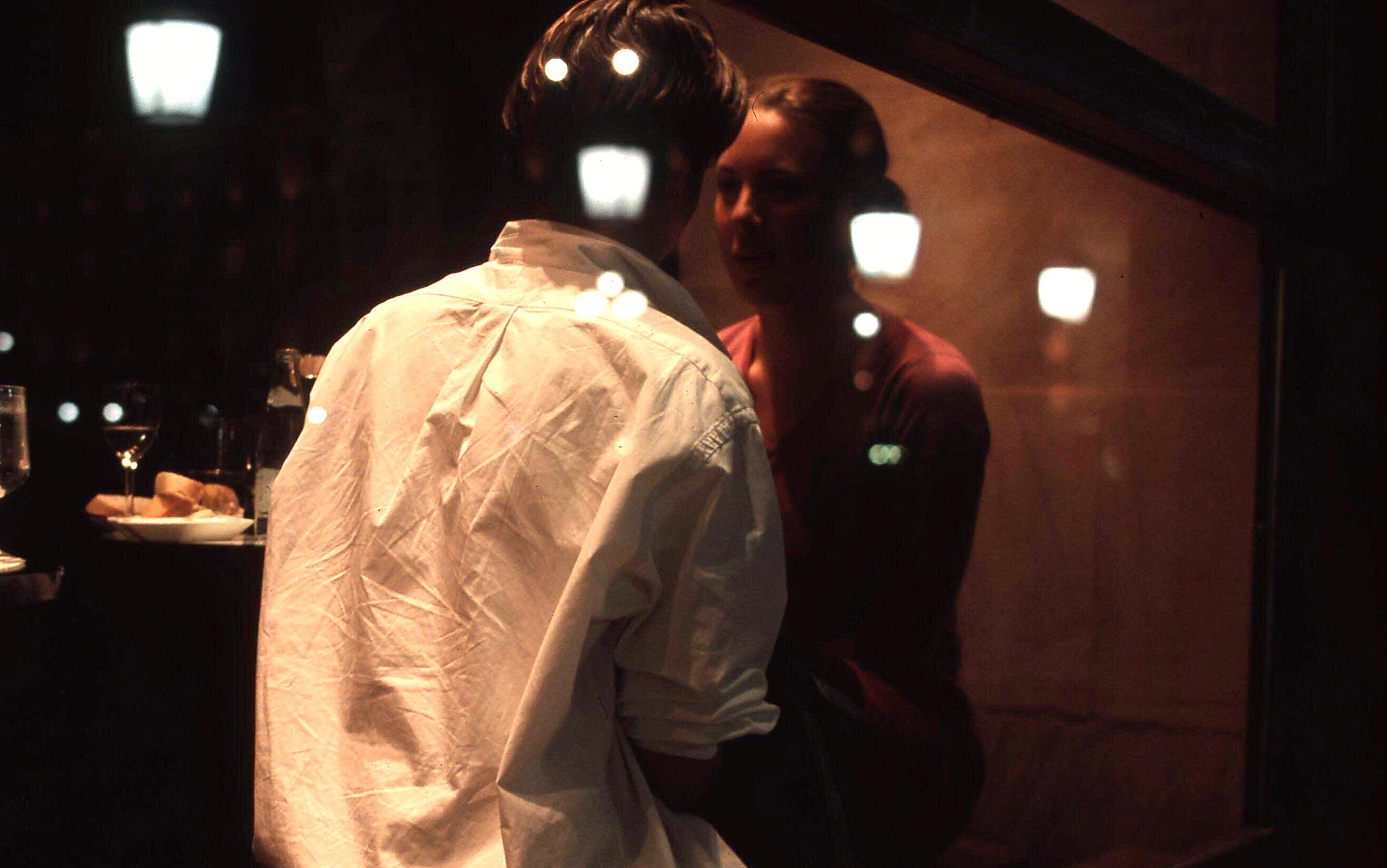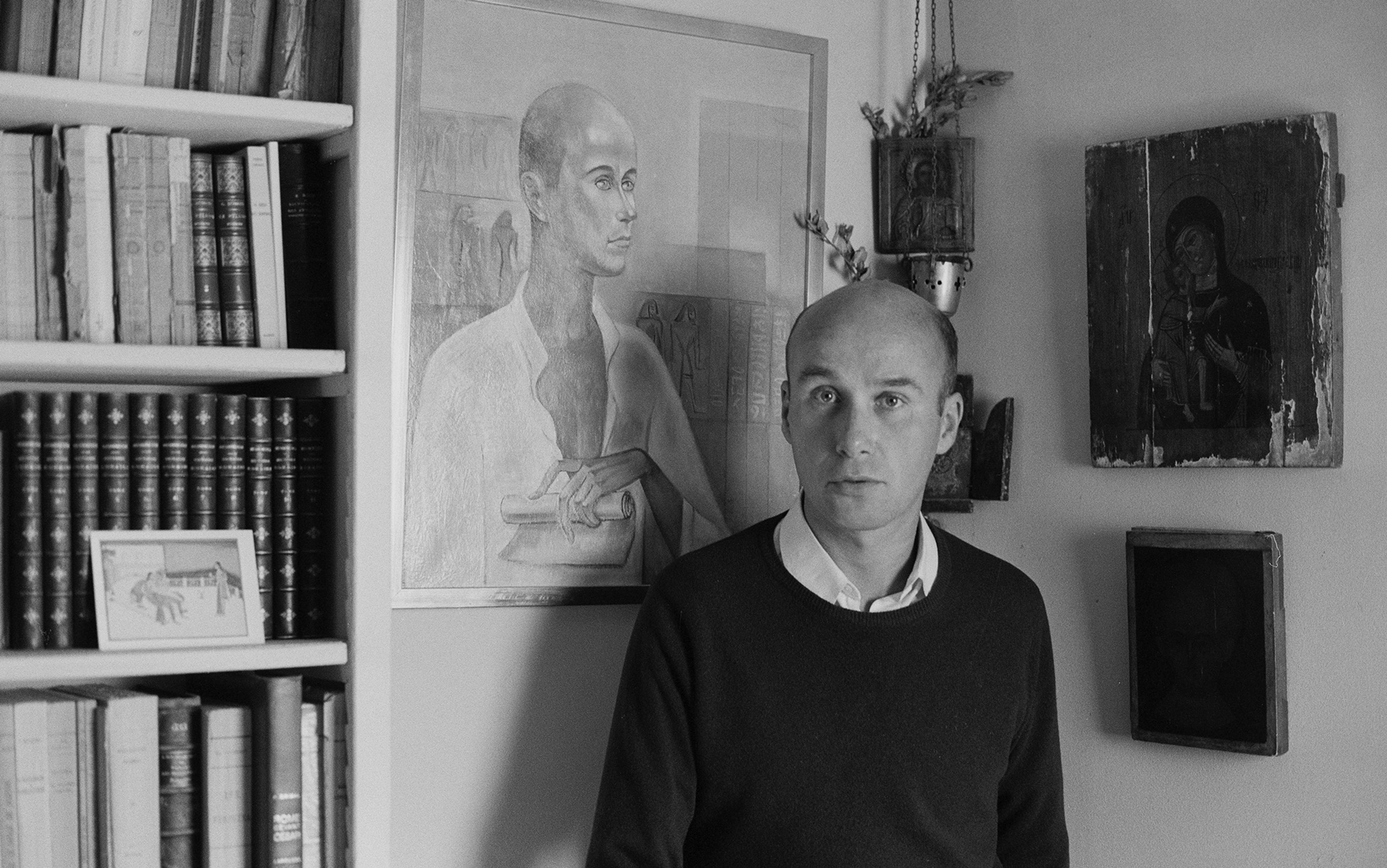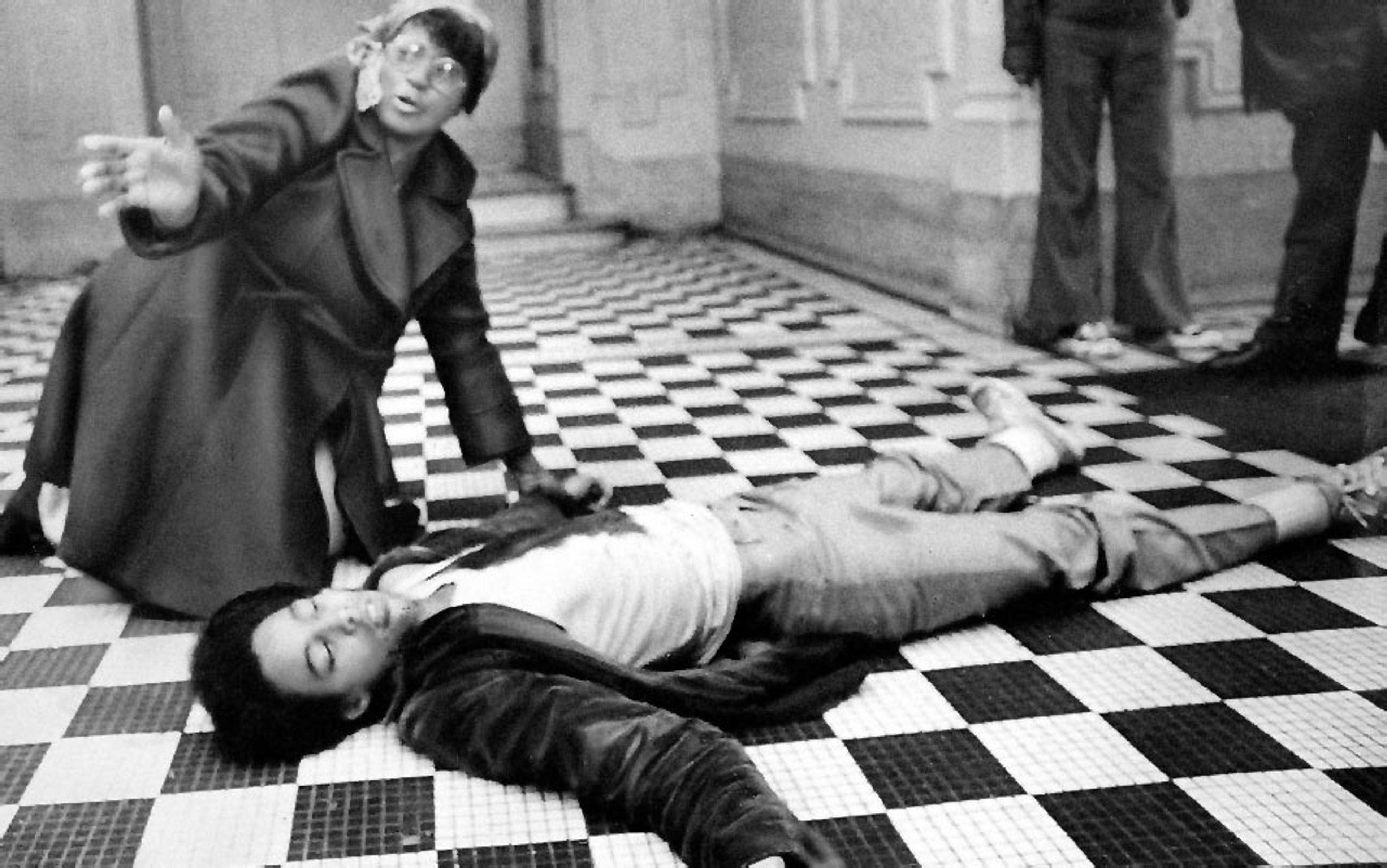One of the most memorable lies about medieval rape appears early in Mel Gibson’s blockbuster film Braveheart (1995). As he ponders how to entice his English noblemen to live in Scotland, King Edward I declares that it’s time to reinstitute an old custom called prima nocte, or first night. He explains: ‘When any common girl inhabiting their lands is married, our nobles shall have sexual rights to her on the night of her wedding.’ (Just to be clear: this ‘old custom’ is fabricated to embellish a compelling narrative of Scottish suffering under English oppression.)
In the next scene, a large group of armed Englishmen interrupts a festive Scottish peasant wedding celebration. While their comrades restrain the struggling bridegroom with a dagger to his throat, two soldiers seize the bride by her arms. She looks back powerlessly at her new husband from the back of the English lord’s horse as it rides away.
Media portrayals of the Middle Ages often depict rape as a routine, legally sanctioned part of life for women, especially servants and peasants. They sensationalise medieval life and imply that things are so much better now by comparison, enabling us to bask in an unearned sense of progress. This fits with other popular ideas about that time period – that life back then was short and violent, marked by gaping disparities between nobles and commoners, and that women had no power whatsoever.
But did medieval rape culture in Europe really look like the Braveheart scene? And how much has actually changed between the Middle Ages and our own #MeToo era? The answers are surprising, and require a bit of unpacking to understand.
In England and Scotland between 1200 and 1600, rape – defined legally as a man having sex with a woman against her will and ‘by force’ – was considered a criminal offence, and there were laws in place to deal with rapists. Women themselves could press rape charges without the help of a father, brother or husband, in contrast to stereotypes of medieval women as helpless damsels in distress, dependent on men to come to their aid. Women could bear witness in court regarding their violation and try to seek justice and reparation. We can still hear their voices today in the form of survivor testimonies from medieval court records. These testimonies are often short on detail and laced with legal jargon, but we can nonetheless read them in the vein of present-day survivor narratives. While short and broad, the medieval documents nonetheless conjure contemporary traumas, such as the gut-wrenching account of Chanel Miller, found unconscious and half-naked behind a dumpster at Stanford University in 2015 after being sexually assaulted by Brock Allen Turner, then a student and swim team champ. Her missive, which went viral, expresses outrage that Turner, who faced 14 years in prison for felony sexual assault, in fact received just a paltry sentence of six months in 2016.
Had that much changed in 800 years?
One case from Glasgow shows how survivor testimonies from the distant past can challenge our contemporary assumptions about medieval women, rape and power. A servant named Isobel Burne claimed that one John Anderson had tried to rape her by accosting her while she was at work. He threw her down on her back and hit her on the head with a clod of earth before ‘speaking sundry abominable words, not worthy of rehearsal’. Anderson confessed that Burne was telling the truth about her experience. As punishment, he was banished from the town ‘for the great offence to God and the slander to Isobel’. Even though Burne was a servant and a woman, the court sided with her rather than her more powerful assailant.
In another case, William de Hadestock and his wife Joan claimed in civil court that James de Montibus had broken into their home in London on a summer evening in 1269 with a group of armed men. One witness corroborated her account and testified that ‘after [James] had entered the house, he closed the door and tore [Joan’s] dress down to the navel, threw her to the ground and raped her, breaking her finger’. The court imprisoned Montibus until he could pay a hefty settlement of £5 to the couple. The rape, which actually occurred before Joan’s marriage to William, didn’t destroy her marital prospects. Instead, her new husband stood by her side in court as she sought justice and fought successfully for monetary compensation.
Other cases feature surprising or unexpected moments that show women seeking justice in a variety of ways. One case from Peebles in southern Scotland points to something resembling contemporary notions of restorative justice: in 1561, Robert Bullo was sentenced to appear before his local church congregation on a Sunday to ask publicly for Marion Stenson’s forgiveness after he raped her.
Some women took justice into their own hands. In a rural area of Shropshire near the Welsh border in 1405, Isabella Gronowessone and her two daughters ambushed Roger de Pulesdon in a field, tied a cord around his neck, cut off his testicles and stole his horse. All three women were subsequently pardoned, implying that they had exacted a brutal form of vigilante justice for rape.
Survivors had to follow several difficult steps in order to have any hope of conviction
Isabella Plomet won a substantial settlement in civil court in 1292 after her doctor drugged her with a narcotic surgical drink and raped her, demonstrating that intoxication-facilitated sexual assault was viewed as a violation that deserved restitution.
In medieval times, rape was categorised legally as a property crime, and thus a felony, with penalties such as castration, blinding or hanging. As you can imagine, criminal convictions for rape were very rare, since all-male juries were reluctant to condemn their fellow men to such harsh penalties on the basis of a woman’s claim, and these penalties were rarely enforced even when the assailant was convicted. Survivors had to follow several difficult steps in order to have any hope of conviction: they were required to report their rapes immediately and publicly, to recount identical narratives of their trauma multiple times to local court officials in their own jurisdiction as well as in neighbouring jurisdictions, and to show evidence of a violent attack – such as torn clothing, bloodstains, dishevelled hair or physical wounds – to ‘men of good repute’. If a survivor wanted to avoid this process or felt that another form of justice would be more fitting, she could negotiate for out-of-court restitution or file a civil case for monetary damages rather than pursuing criminal charges, as Joan de Hadestock chose to do after Montibus raped her in her home. This enabled women to receive tangible recompense for what they’d suffered, and to bypass a complicated and traumatic criminal justice process.
Numerous case records illustrate the inherent flaws and loopholes in medieval systems of rape justice, showing how women could find their charges dismissed if they’d had consensual sex with their rapist before the rape, or failed to follow complicated reporting procedures, or became pregnant from the attack. One case from Wiltshire illustrates the still-common myth that someone cannot claim rape if they previously consented to sex with their assailant: an unmarried woman named Edith claimed that William le Escot raped her in 1249. The record states: ‘It is testified that William lay with Edith but he did not violate her because she was already known to him.’ In other words, because Edith and Escot had had consensual sex in the past, this particular incident didn’t count as a violation. The case features intriguing additional details: Edith also accused a woman named Alice of helping to facilitate Escot’s rape and of stealing a brooch from her.
The pervasive distrust of women in medieval culture – illustrated by popular proverbs such as ‘women can lie and weep whenever they wish’ – meant that women faced an uphill battle in convincing juries that they’d been violated. Legal records repeatedly feature women who bring charges of rape and are subsequently charged with false reporting after the jury concludes that the accused is not guilty or that the victim didn’t properly report her assault.
In Wiltshire in 1249, an unmarried woman named Eve accused Adam Mikel of raping her. Mikel first refused to appear in court, then later denied her claim. The jury agreed that he wasn’t guilty, so Eve was arrested for bringing false charges. She was later pardoned because she was poor.
Other times, women were charged and imprisoned after failing to follow prohibitively specific and difficult reporting procedures. In 1248, Margery, daughter of Emma de la Hulle, testified that a man named Nicholas had raped her outdoors on a summer evening four years earlier, and that she had been a virgin at the time. She specified the location of the rape as ‘between Bagnor and Boxford in a certain place which is known as Kingestrete near Bagnor wood’; search for this certain place online today, and you’ll find maps for scenic walks through Bagnor Wood in West Berkshire. Margery supported her claim against Nicholas with confidence and courage, as the record states that ‘she offers to prove this against him as the court sees fit’. Nicholas responded that Margery didn’t report the assault in a timely fashion, and also neglected to bring her appeal to the neighbouring county court. The jury concluded that Margery’s failure to follow these procedures invalidated her rape charge, and they sentenced her to prison for false reporting, even as they also acknowledged that Nicholas had had sex with her, and required him to pay a fine.
The jury said this was a ‘miracle’ as ‘a child could not be engendered without the consent of both parties’
One disturbing case backfired spectacularly against its victim, Joan Seler, an 11-year-old from London. Seler testified in 1321 that Reymund de Limoges had seized her by the left hand as she stood in the bustling street just a couple of feet from her father’s house at twilight. Limoges dragged her to his rented upstairs chamber and raped her there. The testimony is graphically detailed and agonising to read, in spite of its heavy use of legal jargon; Seler claimed that Limoges took her
between his two arms and against her consent and will laid her on the ground with her belly upwards and her back on the ground, and with his right hand raised the clothes of the same Joan the daughter of Eustace up to her navel, she being clothed in a blue coat and a shift of light cloth, and feloniously … with both his hands separated the legs and thighs of this same Joan, and with his right hand took his male organ of such and such a length and size and put it in the secret parts of this same Joan …
Seler added that the attack left her bleeding, and that Limoges kept her in his chamber all night before freeing her.
Limoges countered that Seler failed to first notify the local coroner of the rape, waited six months to bring charges against him rather than doing so within 40 days, and gave two different dates for the assault in two separate depositions: in one account, she’s claimed it had happened on a Sunday evening, and in another that it was on a Wednesday. Limoges asked the court to dismiss the case due to this discrepancy ‘because she could not twice be deprived of one and the same maidenhead’, joking about the very serious charges against him. The jury acquitted Limoges and ruled that he had sustained £40 in damages, which Seler – as an 11-year-old and a saddlemaker’s daughter – was of course unable to pay. The court ordered Seler be arrested, then pardoned because of her age.
Erroneous beliefs about consent and pregnancy enabled victims to be blamed and perpetrators to escape unpunished. Another verdict resting on such beliefs is the case of a 30-year-old woman named Joan who accused a man known as E of rape in 1313. She had an infant, whom she claimed was conceived from the attack. The jury concluded that this was a ‘miracle’ because ‘a child could not be engendered without the consent of both parties’. The jury exonerated E and sent Joan to prison for making a false report. The jury’s opinion echoed a popular 13th-century law book, which asserted that ‘no woman can conceive if she does not consent’.
People today often bristle at the term ‘rape culture’, dismissing it as feminist hysteria. However, rape culture is a useful framework for making sense of these cases and their outcomes. Even though the medieval legal system designated rape as a crime and contained prosecution mechanisms such as castration, blinding or hanging, medieval culture – which influenced the authorities who wrote the laws as well as the juries who enforced them – enabled the loopholes that prevented many survivors from receiving the justice that they sought. The social scientists Anastasia Powell and Nicola Henry in 2014 defined rape culture as a constellation of widespread attitudes, practices and myths ‘in which sexual violence is tolerated, accepted, eroticised, minimised and trivialised. In a rape culture, violence against women is eroticised in literary, cinematic and media representations; victims are routinely disbelieved or blamed for their own victimisation; and perpetrators are rarely held accountable or their behaviours are seen as excusable or understandable.’
Medieval rape culture was based on several pervasive beliefs about women and sex – that women lie about rape; that they are naturally hornier than men and unable to control their desires; that they habitually change their minds about sex; and that rape must be proved with physical injuries, immediate outcry, repeated identical accounts of the trauma delivered to the proper authorities and copious tears in order to count as ‘real rape’.
In countless medieval texts, women falsely accuse good men of rape when they’re angry, embarrassed or revengeful. Known as the ‘Potiphar’s wife motif’ after the biblical story of a woman who propositions her husband’s servant and, when he rejects her, accuses him of attempted rape, this popular narrative is told and retold dozens of times. One version of this tale, used in sermons to illustrate the evils of lust, features a woman who becomes infatuated with a clergyman who has ‘fair eyes’. She promises to give him all her wealth if he’ll sleep with her. He refuses. Angry at this rejection, she goes to the local justice and accuses the clergyman of attempted rape. The justice believes her and condemns the man to prison. Still brimming with unsatisfied desire, the woman fetches a ladder and climbs up to a window set high in the prison wall, then leaps down into the poor clergyman’s cell and begs him to have sex with her. Once again, he refuses. Prison guards discover the woman in the man’s cell and assume that he has used sorcery to transport her there so he can assault her. He is burned to death as punishment, a victim of the woman’s shameless lies and lust.
This tale imagines a legal system in which women can successfully claim rape without any proof and destroy innocent men’s lives, in contrast to the complicated and treacherous process that real-life victims had to follow. In other texts, manipulative women threaten to accuse men falsely in order to coerce them into sex. In the poem Amis and Amiloun (c1330), a powerful duke’s daughter pines after a handsome knight and tells him that she’ll die unless he becomes her lover. When he refuses, she threatens to tear her clothes and tell everyone that he violated her. She warns that he’ll be hanged as a rapist unless he consents to her advances. Seeing no other option, he promises to marry her. She later sneaks off to his chamber to have sex with him, triumphant that she has gotten her way.
Many elements of medieval rape culture are also central to our own
These tales are based on widespread assumptions that also shaped legal verdicts: that women are more lustful than men and are governed by their sexual impulses; that they are natural liars and manipulators; and that they become hell-bent on revenge when men reject them. As one Scottish proverb says: ‘When a woman wants to sin with a man and is refused, she is more vicious than a bear whose cubs are taken from her.’ Medieval culture also insisted that women habitually change their minds about sex, illustrated by proverbs claiming that ‘women are oft unstable’ and ‘the nature and will of women is variable and easily changed’. This stereotype of women’s natural instability renders their consent essentially meaningless: any ‘no’ could easily turn to ‘yes’, while any enthusiastic ‘yes’ could later transform into a rape accusation.
But this complex of cultural beliefs that I’ve outlined here doesn’t simply illustrate how ignorant medieval people were when it came to sexual violence, nor prove how progressive we are by comparison. Rather, many elements of medieval rape culture are also central to our own. Take, for example, the case from 1313 in which E was acquitted of raping Joan because she became pregnant. Before we attribute this verdict to medieval ignorance about biology and reproduction, we should remember how that very same idea was articulated by the US Senate candidate Todd Akin in 2012, when he insisted that pregnancy from rape is ‘really rare’ because ‘if it’s a legitimate rape, the female body has ways to try to shut the whole thing down’.
The medieval practice of penalising survivors who failed to follow specific reporting procedures persists today too: the Netflix miniseries Unbelievable (2019), based on real events, features an 18-year-old woman charged with falsely reporting her rape due to inconsistencies in her testimony to police, much like 11-year-old Joan Seler 700 years earlier. The judge in the TV series puts the woman on supervised probation, orders her to undergo mental health counselling, and requires her to pay court costs. Local news outlets publish her identity and claim that she ‘cried wolf when it came to her rape’, even though the police later concede that a serial rapist had in fact attacked her. And when in February 2021 the US Congresswoman Alexandria Ocasio-Cortez described herself as ‘a survivor of sexual assault’, those who disagreed with her political views dismissed her disclosure as ‘manipulative’ and ‘histrionic’, echoing medieval assumptions that women claim rape in order to manipulate others.
Both then and now, the legal system and larger culture claim to condemn rape and categorise it as a crime. But, in reality, there are countless built-in loopholes through which violations can go unaddressed, unpunished and even leveraged against victims. Medieval rape culture, in other words, isn’t so different from our own. The threads binding past and present shouldn’t cause us to conclude that changing rape culture is a pointless endeavour; instead, they can inspire us to action by showing us how much farther we still have to go.






